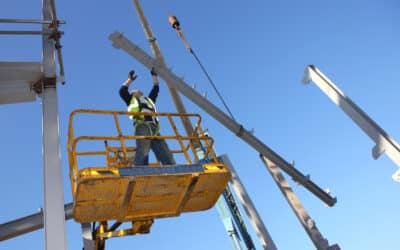Updated: 07/07/2023
Working at heights can be daunting, especially when you know there is a risk of falling. With or without fall arrest equipment, it can be a scary position to be in. However, the risk of working at heights should never be taken without the right equipment.
Safety Services Direct has many years of experience when it comes to ensuring that employees are properly trained and protected from safety risks. So we have put together this guide on personal fall arrest equipment, systems and working safely at heights. Keep reading to find out at what height you need to be equipped so that you can lower the risks and work with confidence.
At What Height Do You Need A Fall Arrest System?
In the UK, workers are legally protected from unnecessary risks at work. These laws are in place to protect employees from dangerous situations and the risk of injury, including those associated with working at height.
Employers have a legal responsibility to provide adequate fall protection equipment, such as personal fall arrest systems, to their workers when the height threshold is met or exceeded. This includes ensuring that the equipment is properly maintained, inspected regularly, and used correctly by trained personnel.
But at what height does this become mandatory? The Work at Height Regulations Act 2005 stipulates that workers have to use fall arrest equipment when working at heights of 2m or more.
However, it’s important to note that the specific height threshold may vary depending on the industry and the nature of the work being performed. In some cases, fall arrest systems may be required at lower heights if there is a significant risk of injury due to a fall. Therefore, it is crucial to assess the specific hazards and consult relevant regulations or guidelines that pertain to your industry.
Complying with the legal requirements for fall arrest systems not only protects workers from injury but also helps create a safer work environment and promotes a culture of safety within the organisation. It is essential to stay updated with the latest regulations and guidelines related to fall protection to ensure full compliance and the well-being of workers at heights.
Note: If you or your employees are working from heights, check out our working from heights training course to ensure that your organisation is legally compliant and safe.
What Equipment Is Required For Fall Protection?
There are three main types of fall arrest equipment. The use of these differs from industry to industry and from situation to situation. Here are the three main options that should be considered when working from heights above 3m.
Personal Fall Arrest Systems
A personal fall arrest system is an individual piece of equipment that will arrest your fall if you should drop down. These systems include a body harness or body belt, anchorage and connectors. These systems are used when working well above 3m, as you will still drop for the length of the hardness or anchorage, and it is important not to touch the ground when doing so.
Guardrail Systems
Guardrails are a fall protection system that doesn’t require workers to wear personal protection or be trained in use. Much like a handrail on a staircase, guardrails protect workers from falling. In the UK, guardrails must be capable of withstanding at least 200 pounds of force within two inches of the top, along any point of the guardrail. This ensures that it can hold out against the weight of an average man, which is 183 pounds in the UK.
Safety Net Systems
A safety net system is a passive fall protection option and should only be considered as an additional safety measure. Safety nets can be used to catch a falling worker or as a barrier. But seeing as nets only decrease the fall distance and reduce the likelihood of serious injury, they should be used in conjunction with guardrail systems so that if one doesn’t work, the other will.
Final Thoughts On Personal Fall Arrest Systems
When working from heights, it is crucial that your safety is taken into account. Unfortunately, even falls from heights below the legal height can be dangerous and even fatal, so it is best to install guardrails at all heights as a preventative measure.
If you would like to know more about fall arresting equipment, height safety signs, or our safety courses, please get in touch with us today.







